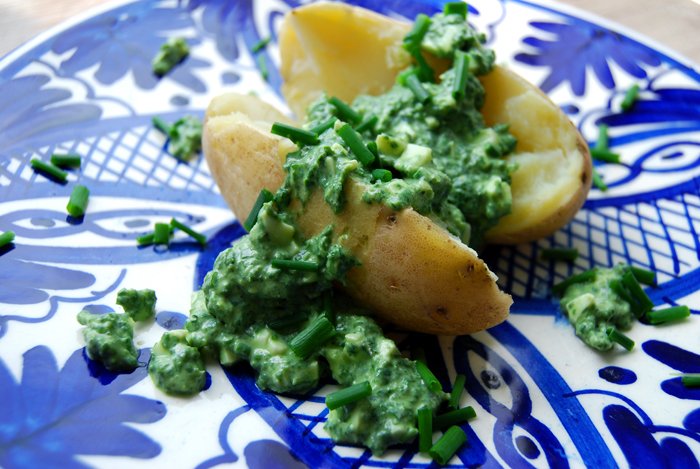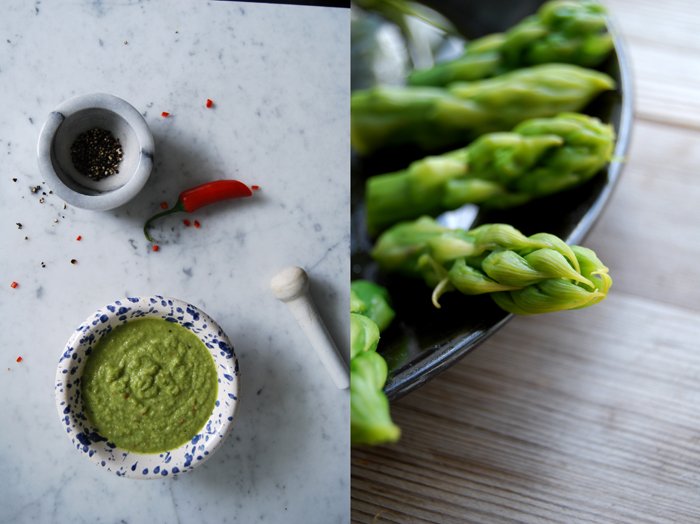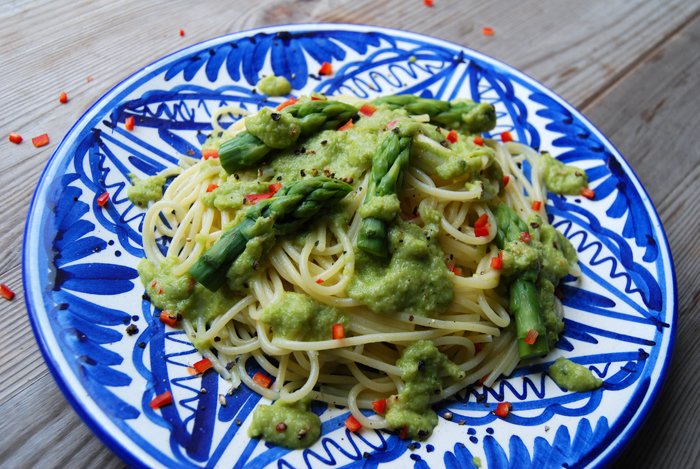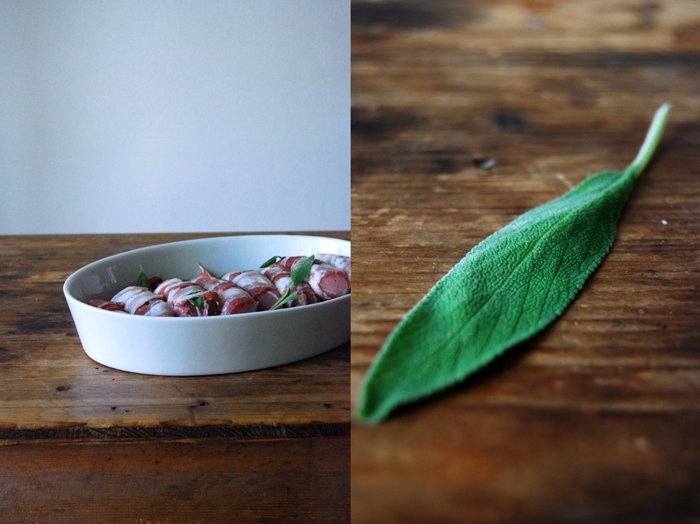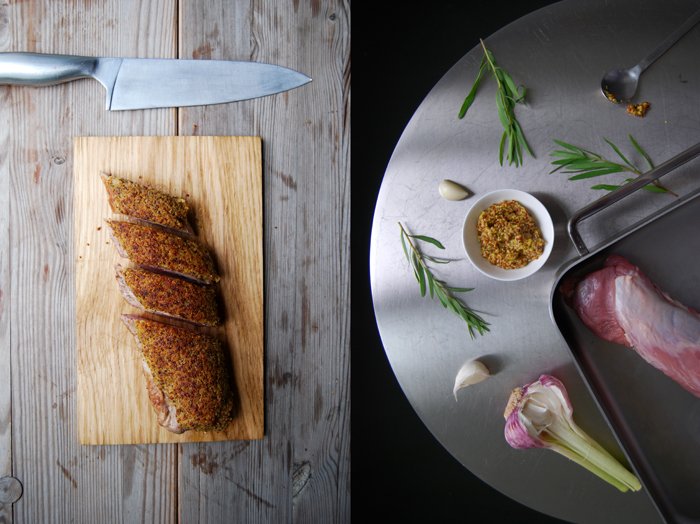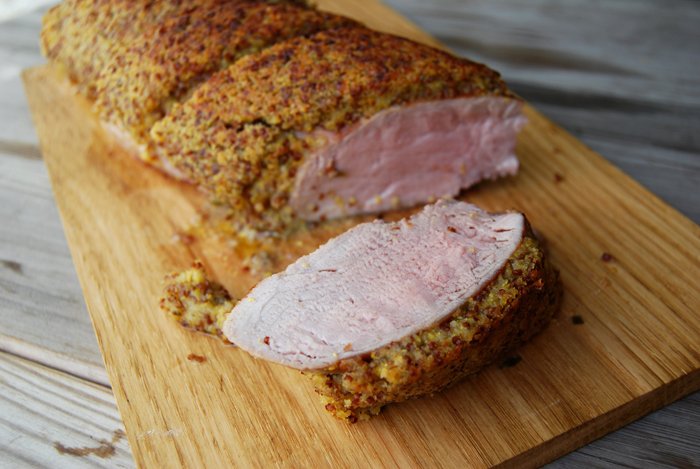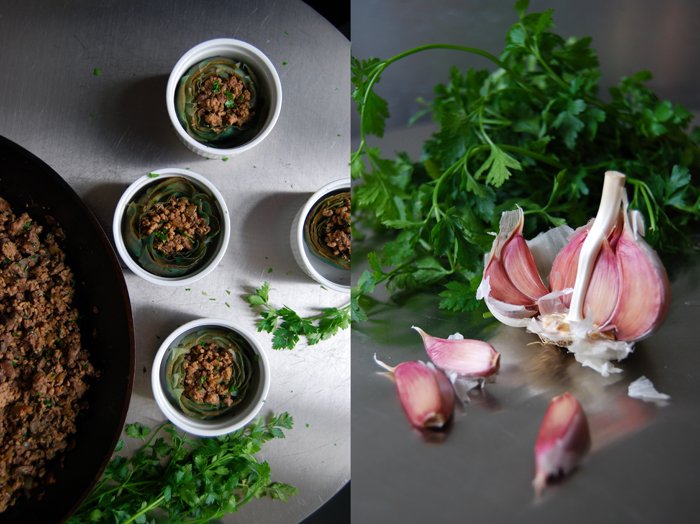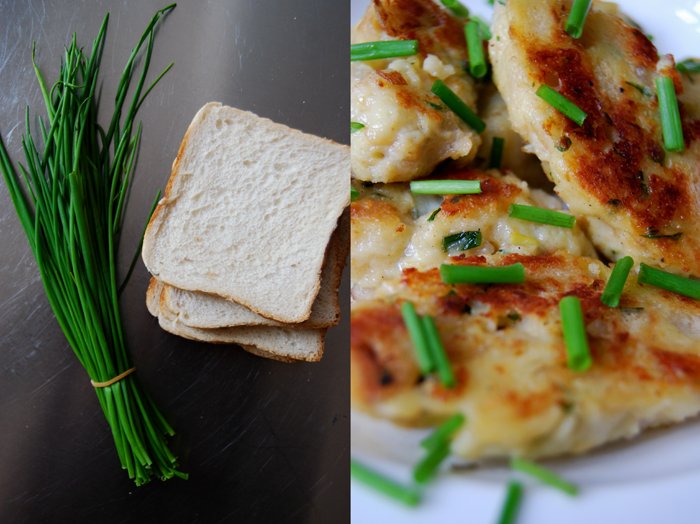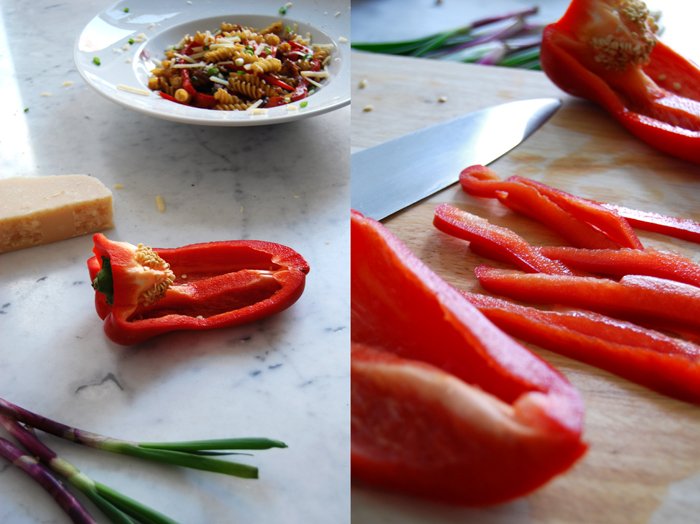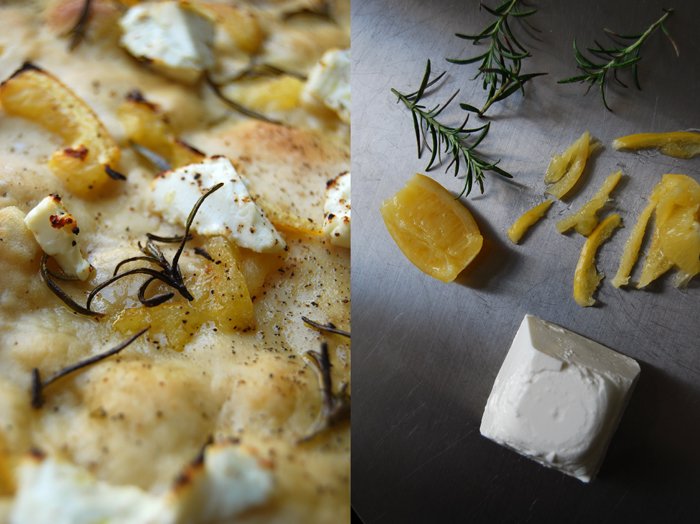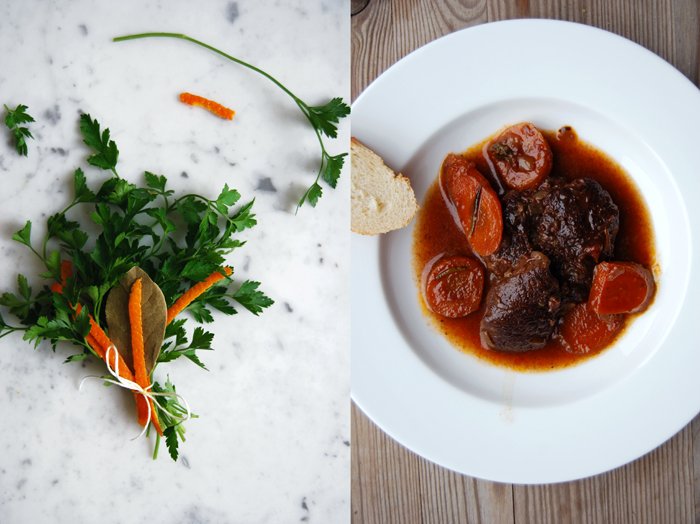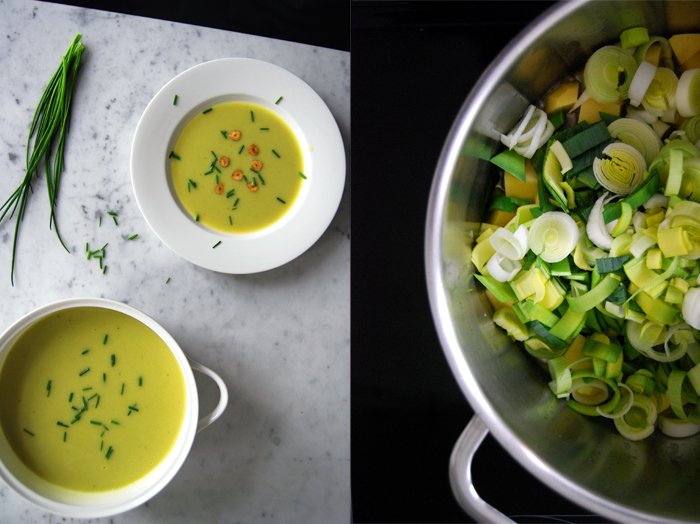Frankfurt Green Sauce - 7 Herbs and Spring Potatoes
Sorrel, borage, chervil, burnet, parsley, chives and garden cress, these are the 7 herbs which make up the traditional Frankfurt Green Sauce. Similar to the Italian Salsa Verde or the French Sauce Verte, which are also mainly made of herbs, the famous German version is made of greens growing in the Frankfurt area. Legend has it that the origin of the green herbal sauce is in the Orient and it was brought to Europe by the Romans more than 2000 years ago, enough time for each region to create their own, unique recipes. Apart from the right selection of herbs, there isn't "one" recipe for this sauce from Frankfurt. They all vary, some add heavy cream, sour cream, yoghurt or mayonnaise, some are made with onions, garlic or mustard, but most involve a hard boiled egg.
I developed my own recipe a few years ago when I used to live close to the city of the sauce's origin. To me, the sauce needs 2 crumbled hard boiled eggs, sour cream, olive oil, lemon juice, a little heavy cream for some sweetness, white Balsamico vinegar and salt and pepper, but the focus is definitely on the herbs, you need a lot, 200g / 7 ounces in total!
Traditionally the cold sauce is eaten with boiled spring potatoes, some serve it with cold meat but I prefer to keep it simple and light, the sauce is so fragrant and aromatic that the mild potatoes fit just perfectly.
Frankfurt Green Sauce with Spring Potatoes
For 2-3 people you need
medium sized potatoes, boiled and peeled, 4-6
For the sauce
mixed herbs (sorrel, borage, chervil, burnet, parsley, chives and garden cress) 200g / 7 ounces
organic eggs, hardboiled, chopped finely, 2
sour cream 5 tablespoons
olive oil 2 tablespoons
freshly squeezed lemon juice 2 tablespoons
heavy cream 1 tablespoon
white balsamic vinegar 1 tablespoon
salt and pepper
Chop the herbs with a knife finely or mix in a blender. Put the herbs in a big bowl and add the eggs, sour cream, heavy cream, olive oil, lemon juice and vinegar and stir until combined. Season with salt and pepper to taste and serve on top of the potatoes.
Lemon-spiced Chicken Wings with Cumin, Harissa and Mint Yoghurt
Chicken wings are often underestimated, unfortunately. Their tasty meat is packed in between the bones which keeps it juicy and due to the short roasting time it doesn't dry out. There isn't much meat on the wings which is an advantage to me as I prefer a small portion of meat especially when it's getting closer to summer and the temperatures rise. It's definitely enough for a spicy treat together with some aromatic cumin, harissa, lemon juice and a few slices of my Moroccan preserved lemons (which you could replace with lemon zest).
The spices and lemon made a delicious skin, golden and crisp after 20 minutes in the oven and packed with wonderful aromas. I like to eat the wings with my fingers, to feel their sticky juices and dip them in a refreshing sauce of yoghurt, sour cream, lemon and mint.
You could also throw them on the grill which would add some smoky flavours or take them out with you on a summery picnic. It's almost June and my mood calls for an early summer picnic with friends and lots of pots and plates of delicious food, so one dish is already sorted!
Lemon-spiced Chicken Wings with Cumin, Harissa and Mint Yoghurt
For 2 people as a main you need (we had half for lunch)
chicken wings 8
olive oil 4 tablespoons
freshly squeezed lemon juice 2 tablespoons
ground cumin 1 teaspoon
harissa 1 teaspoon
black peppercorns, crushed, 10
preserved lemon, sliced, 1/4 (or lemon zest 1 teaspoon)
coarse sea salt
For the yoghurt dip
yoghurt 4 tablespoons
sour cream 2 tablespoons
freshly squeezed lemon juice to taste
mint leaves, chopped, 10
salt and pepper
Set the oven to 210°C / 410°F top / bottom heat.
Whisk the olive oil with the lemon juice, cumin, harissa and black pepper and stir in the slices of the preserved lemon or the lemon zest. Place the chicken wings in a baking dish or on a baking sheet and coat with the spice oil. Sprinkle with salt and roast for 20 minutes or until golden and crisp.
Mix the yoghurt, sour cream, lemon juice, mint, salt and pepper and whisk until creamy.
We ate this with a simple green salad on the side and some baguette to dip into the juices. The French bread was also great with the yoghurt dip although Naan bread would have been more authentic.
Zucchini, Bell Pepper and Aubergine Moussaka with Lemon Ricotta
My Moussaka, truth be told, is a fruity ratatouille baked with a fluffy lemon ricotta soufflé on top. The traditional Greek Moussaka is made with a Béchamel sauce which I'm not too fond of. I like this creamy sauce in my lasagna or cannelloni but that's it. The ricotta tastes much lighter, enhanced with lemon zest, nutmeg, parmesan and fresh basil, it gives this dish more of a summer feeling. Contrary to the Greek version, I kept mine vegetarian, there's no minced meat involved, just zucchini, bell pepper, tomatoes, red onions, lots of parsley and a velvety layer of fried aubergine slices in between the vegetables and the cheese. It stops the ricotta from running into the juicy ratatouille.
When I cook a ratatouille I always make a big batch. This moussaka is perfect as a second day dish for ratatouille leftovers. Topped with the ricotta it just has to bake in the oven for half an hour, great if you have friend's over for dinner and not much time for preparations! I baked it in small casserole dishes closed with a lid so that each of us could have our own little pot.
Zucchini, Bell Pepper and Aubergine Moussaka with Lemon Ricotta
I bake the Moussaka in two 12,5cm / 5" casserole dishes with lids, you could use a big one instead but you may have to bake it a bit longer for the ricotta to set.
For 2-3 people you need
small aubergine, sliced into circles, 1
zucchini, sliced into circles, 1
red bell pepper, thinly sliced, 1
big red onion, quartered and thinly sliced, 1
big tomatoes, chopped, 4
garlic, thinly sliced, 3 cloves
parsley, chopped, 2 tablespoons
balsamic vinegar 2 tablespoons plus more to taste
olive oil for frying
salt and black pepper
For the topping
ricotta 260g / 9 ounces
organic eggs 2
Parmesan, grated, 30g / 1 ounce
small basil leaves, chopped, 30
lemon zest 1 teaspoon
lemon juice 1 teaspoon plus more to taste (I also added a little of the liquid of my Moroccan preserved lemons)
nutmeg, ground
salt and pepper
Spread the slices of aubergine on a baking dish and sprinkle with salt on both sides to pull some of its water out. Let it sit for around 15 minutes, rinse the slices and dry between kitchen roll paper. In a large heavy pan, heat a splash of olive oil and fry the aubergine for a few minutes on both sides on medium temperature until golden and soft, add a little more oil if necessary. Season with salt and pepper and set aside.
In a large pot, heat a splash of olive oil and fry the onion for a few minutes until golden and soft. Add the bell pepper and garlic and fry for 2 minutes before you add the zucchini. Fry the vegetables for 2-3 minutes and deglaze with 2 tablespoons of balsamic vinegar. Add the tomatoes, season with salt and pepper and cook for 10 minutes. Add the parsley and season with balsamic vinegar, salt and pepper to taste.For the topping, mix the ricotta, eggs, parmesan, basil, lemon zest and juice and season with nutmeg, salt and pepper to taste.
Set the oven to 200°C / 390°F top/ bottom heat.
Divide the vegetables between the 2 casserole dishes, cover with 3-4 slices of aubergine and spread the ricotta mixture gently on top. Cover with lids and bake for around 35 minutes until the ricotta mixture is set.
Spaghetti with Green Asparagus Anchovy Pesto
Asparagus season could be extended for months if it were up to me! So many recipes bring out different sides of this vegetable, be it green or white asparagus, it's so versatile thanks to its strong taste.
So here’s an asparagus pesto, light and fresh with a smooth texture, almost velvety. The preparation is the same as the broccoli pesto I made in March, the cooked vegetables are mixed with some of the water they are cooked in. I added garlic, fresh hot chili peppers, tarragon (my herb of the month) and anchovies. The fish adds subtle saltiness, which really makes this composition complete. I once made this pesto without the fish as I had run out and it really wasn't as good. I use 4 anchovies for 500g (1 pound) of asparagus, I originally started with just 2 when I made it the first time. I thought they would be too strong for the pesto but sometimes in cooking you shouldn't be shy, being bold and brave is the key to success!
For more asparagus recipes, click here!
Spaghetti with Green Asparagus Pesto and Chili Peppers
For this meal it’s best to warm up the plates in the oven.
For 2 hungry people you need
spaghetti 200g / 7 ounces
green asparagus, the woody bottom part cut off, 500g / 1 pound
water used to cook the asparagus 30ml / 2 tablespoons
olive oil 60ml / 1/4 cup
freshly squeezed lemon juice 1 tablespoon
anchovy preserved in salt, rinsed and dried, 4 fillets
garlic, crushed, 3 cloves
tarragon 12 leaves
fresh red chili pepper, finely chopped, 1, half for the pesto the rest for topping
salt and pepper
Cook the spaghetti al dente.
In a large pot, cook the asparagus in lots of salted water for 7 minutes. Keep the water, take the asparagus out with a slotted ladle and cut into 3cm / 1″ pieces. Set the heads aside and leave for the topping.
Purée all the ingredients for the pesto in a blender (except the asparagus' heads and the chili peppers for the topping). Season with salt (carefully, I didn't need to add any because of the salty fish), pepper and lemon juice to taste.
Arrange the spaghetti, pesto and asparagus' heads on the warm plates and sprinkle with chili and crushed black pepper.
Rabbit wrapped in Sage and Bacon roast on Rhubarb
Sweet and sour rhubarb, salty bacon and aromatic sage wrap my juicy pieces of rabbit in a delicious composition of spring flavours. You could use pork fillet in this recipe as well but I like rabbit meat, it's tenderness and unique taste. We often eat it when we're in Malta where rabbit is so popular that it became the national dish. Be it as a Mediterranean stew with olives, tomatoes and wine, often cooked together with pork for a stronger aroma, or in a pie, I've enjoyed some of the best rabbit meals on this island!
Rabbit meat isn't very challenging to cook as long as it's kept moist and not overcooked. The little packages of sage and bacon in my recipe infuse the meat with their flavours but also keep it juicy. The steaming rhubarb roasting under the meat has the same effect. Its juices add a fruity taste to the meat and make sure that it doesn't dry out while it's cooking.
Rabbit wrapped in Sage and Bacon roast on Rhubarb
For 4 people you need
rabbit, without bones, 500g / 1 pound for 8 portions (I bought rabbit back and legs, the fillets from the back were the easiest to prepare)
rhubarb, cut into 5cm / 2" pieces, 500g / 1 pound
granulated sugar 3 tablespoons
garlic, thinly sliced, 3 cloves
fresh sage 16 leaves
bacon 8 slices
white wine 75ml / 2.5 ounces
olive oil 2 tablespoons
salt and pepper
Set the oven to 210°C / 410°F. My oven has a Rotitherm roasting setting which works perfectly for this recipe.
Cover the bottom of a baking dish with the rhubarb mixed with sugar. Season with salt and pepper.
Divide the rabbit in 8 portions, season with salt and pepper and wrap each portion in a slice of bacon together with 2 leaves of sage and 3 slices of garlic. Place on top of the rhubarb and pour the wine and olive oil over it.
Bake in the oven for 20 minutes, pouring some of the juices over it from time to time. For the last 3 minutes sprinkle the bacon with some sugar.
A warm Salad with Artichokes in Vermouth
Artichokes seem to follow me in the past few weeks, even when I don't buy them they end up in my kitchen. I got a bag full of beautiful purple baby artichokes as a gift, the tiniest I've ever seen. A friend of mine had bought too many and knowing that I use everything that finds its way into my space she was happy to pass them over to me. I had already made plans for dinner but the vegetables couldn't wait a day longer. When I looked at them, a warm salad came to my mind, a little snack in between. I imagined them sautéed and deglazed with vermouth and some parsley on top, so I brought out my pan and started the cooker.
As a starter for 4 you need 6 small baby artichokes. Cut off the artichoke stem if it’s too woody and pluck the hard outer leaves. Cut the artichoke’s tip off (1/3 – 1/2 of the artichoke), quarter them and scoop out the hairy choke. Keep the prepared artichokes in a bowl of cold water and the juice of half a lemon while you’re finishing the rest.
Sautée the prepared artichokes in a large heavy pan in a dash of olive oil and 2 tablespoons of butter for about 5 minutes together with 1 thinly sliced clove of garlic. Deglaze with 75ml / 2.5 ounces of vermouth and season with salt and pepper. Add 75ml / 2.5 ounces of water and 1 tablespoon of freshly squeezed lemon juice and let them simmer on a medium heat for about 10 minutes until al dente. Sprinkle with roughly chopped parsley and season with salt and pepper to taste.
Gratin with Cauliflower and Garlic Mashed Potatoes
This is a recipe my father used to make for us when we were children. We all loved it because of the cheese and mashed potatoes! I still do as it's one of the few dishes made with cauliflower that I really like.
When I wrote about my ginger, lemon and cauliflower soup I mentioned that I don't use this pretty white cabbage so often in my kitchen, I only like it in a few combinations. I don't have anything against its unique taste, it just needs the right treatment to bring out its sweet side. The mashed potatoes are a good choice, seasoned with nutmeg which I also use for the cauliflower to refine its taste, they are a good match. I didn't want to disturb the mild flavours in the gratin so I picked a soft cheese for the crunchy crust, not too ripe and overpowering. I used a hard Gouda, this Dutch cheese melts well and develops a nice crust under the grill, it's also the cheese my father used for this meal.
This recipe is very simple to prepare, a whole cauliflower cooked in one piece, pushed into creamy mashed potatoes and baked with cheese to a golden gratin. If you need a quick dinner for a handful of people, this is the perfect choice!
Gratin with Cauliflower and Garlic Mashed Potatoes
For 4 people you need
a whole cauliflower, around 700g / 25 ounces
potatoes, peeled, 650g / 23 ounces
garlic, in its skin, 3 big cloves
milk 200ml / 7 ounces
butter 50g / 2 ounces
nutmeg, freshly ground
salt and black pepper
hard cheese (Gouda, Emmentaler or cheddar), thinly sliced, 100g / 3.5 ounces
Cook the potatoes together with the garlic in salted water for 20 minutes. Rinse the potatoes under cold water for a few seconds and peel the garlic. Mash the potatoes together with the garlic, milk and butter, whisk and season with salt, pepper and nutmeg to taste.
Cook the cauliflower in lots of salted water al dente (around 10 minutes), it should be soft with bite without falling apart.
Scrape the mashed potatoes into a baking dish, put the cauliflower on top and push it down. Season the cabbage with salt, pepper and nutmeg and cover it with the cheese. Bake under the grill for a few minutes until golden brown, bubbly and crisp, slice like a cake and serve immediately.
A Field in the Forest, Beelitz and Asparagus Soup
A couple weeks ago I had a conversation about asparagus with my aunt and uncle, we talked about the various tastes depending on the vegetable's origin. The soil, the climate and weather have such a big influence on these delicate stems. I've enjoyed great asparagus in my life, green and white, but we agreed that the best is from Beelitz, an area 50 km (30 miles) outside Berlin. I always wanted to visit to see the large fields covered in foil keeping them dark, to watch the harvest and buy my asparagus directly from one of the farmers.
It's May, the seasonal peak for asparagus and there's no time to wait any longer! A few days ago we got on a train heading South-West to search for the famous Beelitz asparagus fields. We took our bikes with us to explore some of the quiet and hidden corners of the countryside, the forest and the fields and I can say that we found what we were looking for, asparagus heaven!
We got off the train at a tiny station, an old timber framed house which seemed abandoned for years. We noticed that we were the only travelers on the platform, we were happy about that and enjoyed the silence. When you live in the city the absence of noise is one of the biggest luxuries! The early afternoon sun felt just right, soft and warm, we jumped on our bikes, excited to start our trip.
Beelitz is a small town, it's peaceful and pretty. Old brick houses line the narrow cobblestone streets, little trees along the pavements blossoming in bright pink, a perfect picture book scene. It didn't take us long to leave the town behind us. The world in front of us turned into a glowing green, majestic trees with fleshy leaves, lilacs blooming at every corner spreading their sweet scent. The grass on the wide meadows looked fresh and juicy. We crossed a river and filled our lungs with the cleanest air we smelled in months! We turned into a tiny path and met an old man gathering grass for his rabbits. We chatted for a little while before we continued our drive along endless fields, on hidden alleys and through lonesome forest.
After driving through a dark forest of pine and fir trees for about half an hour we noticed a sparkle in the distance. At that point we weren't even thinking about asparagus anymore, we just enjoyed the peace and quiet, but there it was, right in front of us in the middle of hundreds of trees, an endless field of asparagus!
To keep the vegetables in the dark, they are covered with white foil which reflects the sun and creates a surreal, glittering scene, it felt like being on the moon! In the evening, on our way back to the train station we saw the pickers coming to harvest, creating dark shadows in front of a blinding white in the spotlight of the sinking sun. It was beautiful!
Behind the fields we spotted a farmer who offered thick and juicy white asparagus, the freshest I've ever bought. I filled my basket with the clean white stems knowing that I would turn a few of them into a delicious asparagus soup!
Asparagus Soup
For 4 people you need
white asparagus, peeled, the bottoms cut off, 1kg / 2 pounds
a pinch of sugar
water used to cook the asparagus 900ml / 2 pints
heavy cream 100ml / 3.5 ounces
nutmeg, freshly ground
salt and black pepper
tarragon, around 30 leaves for the topping
In a large pot, bring lots of water to a boil, add a pinch of sugar and salt and cook the asparagus for 20 minutes. Keep the water, take the asparagus out with a slotted ladle and cut into 3cm / 1" pieces. Set the heads aside and leave for the topping.
Bring 900ml / 2 pints of the water used to cook the asparagus to a boil and cook together with the cream on a medium heat for 5 minutes. Add the asparagus and purée with a stick mixer or in a blender. Season with salt, pepper and nutmeg to taste and serve in deep bowls sprinkled with the asparagus' heads and tarragon leaves.
Pork Fillet with a Grainy Dijon Mustard and Tarragon Crust
I don't need meat on my table often, once a week is enough for me, but on some days my hunger needs more than just vegetables. This week I got hooked on a nice piece of pork fillet which when properly prepared is uncomplicated, juicy and also great as a leftover meal. I bought a whole 600g (1.5 pounds) of fillet knowing that it would be a bit much for the two of us but we were happy to enjoy it the next day, cold cuts at its best!
Pork fillets are always delicious in combination with herbs, with sage for example, you could wrap the meat in prosciutto similar to a Saltimbocca alla Romana but I felt like mustard, a spicy, grainy mustard crust enhanced with the flavours of tarragon. When I make a crust, I like a thick, slightly crunchy cover on the meat, concentrated and strong. The classic Dijon mustard with its fine spiciness would work as well but the rougher, grainy one makes a better crust. Dijon mustard's history goes back to 1856, when Jean Naigeon of Dijon first substituted verjuice (the acidic juice of unripe grapes) for the normal vinegar.
Sometimes, meat dishes are quicker and easier to prepare than vegetarian meals, this is one of them. I mixed the ingredients for the crust in a blender, fried the meat and baked everything in the oven for just 15 minutes. After frying the meat, I deglazed what was left in the pan with vermouth which turned into a thick juice. The meat didn't really need a sauce but it was nice to dip it into this concentrated syrup.
Pork Fillet with Mustard and Tarragon Crust
For 4 people you need
pork fillet, one piece of 600g / 21 ounces
butter 40g / 1.5 ounces
dry breadcrumbs 20g / 3/4 ounce
whole-grain Dijon mustard 3 heaping tablespoons
garlic, crushed, 1 clove
tarragon, chopped, 14 leaves
salt and pepper
olive oil for frying
vermouth, 150ml / 5 ounces
Set the oven to 200°C / 390°F (top/ bottom heat).
Mix the butter, bread crumbs, mustard, garlic and tarragon in a blender and season with salt and pepper. Roll out the paste between 2 layers of cling film, it should have roughly the shape as the pork fillet.
In a large heavy pan, heat a splash of olive oil on high temperature and fry the meat seasoned with salt and pepper for a few minutes until golden brown on all sides. Take the meat out of the pan and deglaze the bits and pieces left in the pan with the vermouth. Let it cook for 30 seconds, season with salt and pepper and take off the heat.
Put the meat into a baking dish, cover with the mustard butter paste and press it softly onto the meat. Bake in the oven for 12 minutes, switch to grill function and let the crust turn brown and crisp for 3 minutes.
Serve the meat in thick slices with a few drops of the thick concentrated vermouth sauce.
Parmesan Risotto with crisp Fava Beans
When my sister told me abut her latest risotto discovery from her trip to Italy, she sounded so thrilled that I couldn't wait to get the pot on the cooker. She was talking about a parmesan risotto which by itself isn't necessarily spectacular but this one is different. It's made with bigger pieces of cheese which are stirred into the creamy rice when the risotto is done. The parmesan melts, partly, but a few crumbs keep their crunchy center which makes it taste stronger, more concentrated. I was absolutely impressed, this method of preparation lifts parmesan risotto onto another level!
I had some fava beans left on my window sill which I added to the rice, I prefer to have some vegetables with my risotto. Be it a simple salad or some sautéed greens on the side, I need my vitamins as much as my carbohydrates! I fried the beans with some garlic, deglazed them with white wine and let them simmer for a few minutes. I wanted them al dente, a crisp topping for my smooth risotto!
I cooked the risotto with the water I had used to cook asparagus in a few days ago. It's a light broth which I always keep and freeze, great for recipes which need a soft vegetable aroma.
Parmesan Risotto with Fava Beans
For 4-5 people you need
Arborio rice 400g / 15 ounces
medium size onion, chopped finely, 2
broth around 2200ml / 4.5 pints
Parmesan, cut into 1cm / 1/2" cubes, 80g / 3 ounces
fava beans, peeled out of their pods and shells, 800g / 28 ounces (around 300g / 10.5 ounces peeled beans)
garlic, roughly chopped, 1 clove
white wine 120ml / 4 ounces
salt and black pepper
olive oil for frying
butter 2 tablespoons
In a large pan, heat a little olive oil and 1 tablespoon of butter, add the garlic and beans and fry on a medium heat for a few minutes until golden. Deglaze with half of the wine and let it cook for a minute. Season with salt and pepper and add the rest of the wine, close with a large lid and let it simmer for 5 minutes or until al dente. Season with salt and pepper to taste.
In a large pot, fry the onions in a little olive oil and 1 tablespoon of butter until golden and soft, stir in the rice and fry on a medium heat for a minute. Add some of the broth, the rice should be covered, stir and turn the heat down to medium-low. When the liquid has been absorbed add more broth, a little at a time stirring in between. Depending on the rice, it needs more or less liquid. When the rice is al dente and the broth is more or less absorbed take it off the heat, season with salt and pepper to taste and stir in the Parmesan, close with a lid and let it sit for a minute. Arrange on plates together with the fava beans.
Stuffed Maltese Artichokes with Meat and Brandy
In Maltese cuisine, stuffed vegetables have a long tradition. The island's soil and climate offer the right conditions for fruits and vegetables to grow and ripen under the Mediterranean sun with strong tastes and in huge quantities. Tomatoes, onions, marrows, zucchini, aubergines, pumpkins, all fruits and vegetables that are perfect to be filled! Be it with meat, seafood, herbs or other vegetables, you can combine flavours of all kinds or even use your leftovers to create a completely new dish you would have never thought of before. When I'm in an experimental mood, I bravely mix whatever I find in my fridge and shelves, sweet, sour, spicy or bitter, I've never been disappointed, but often surprised!
A few weeks ago I wrote about my stuffed zucchini, the filling was light and fluffy, made of ricotta, basil and lemon, perfect for the fruit's soft taste. When I decided to stuff some baby artichokes I had a stronger filling in mind, hearty, with minced pork and chicken liver which is an old, traditional Maltese recipe. To refine the meat's flavours I deglazed it with sweet brandy and infused it with an aromatic bay leaf and a pinch of cumin. I prepared everything in advance and warmed it up in the oven for a few minutes before dinner, in my little ramekins. The meal pretty and delicious!
Stuffed Artichokes with Minced Pork, Chicken Liver and Brandy
The artichokes can be prepared in advance and warmed up in the oven before serving.
For 6 stuffed baby artichokes you need
baby artichokes 6
minced pork 220g / 8oz
chicken liver, cleaned and finely chopped, 150g / 5 1/2oz
medium sized onion, finely chopped, 1
garlic, crushed, 2 cloves
brandy 40ml / 1 1/2fl oz
white wine 160ml / 5 1/2fl oz
bay leaf 1
cumin, ground, a pinch
parsley, chopped, the leaves of a small bunch
salt and black pepper
olive oil
juice of 1/2 lemon
Cut off the artichoke stems. If they are soft, peel and chop them finely and set aside. Pluck the hard outer leaves and cut the artichokes' tips off (1/3 – 1/2 of the artichoke), just the soft, fleshy part of the leaves should be left. Loosen the hairy choke with a knife and scoop it out with a spoon. Keep the prepared artichokes in a bowl of cold water and the juice of half a lemon once they are cut.
In a large pot, cook the artichokes in lots of salted water for about 10 minutes or until soft.
Set the oven to 200°C /390°F.
In a large heavy pan, heat a splash of olive oil and sauté the onion and garlic on medium for a few minutes until soft. If the artichoke stems are soft add them as well. Add a little more olive oil and fry the minced meat for 2-3 minutes. Add the liver, stir and fry for a minute. Add the bay leaf, parsley and cumin, deglaze with brandy and pour in the white wine, cook it down for 2 minutes. Season with salt and pepper and fill the artichokes with the minced meat mixture.
Place the artichokes in a big baking dish or 6 single ramekins, add a dash of white wine to cover the bottom of the dish and cook them in the oven for 5 minutes.
Octopus Stifado, a Greek Stew with Octopus, Onions and Mint
A spontaneous decision took me to the island of Naxos in the Aegean sea on a warm early autumn evening a few years ago. My summer holidays had been cancelled due to my work and in late September I felt an urgent need for a break. I had never been to Greece before and when I saw the photos of this dry, quiet island and it's long and lonely beaches I knew that this was exactly what I had been looking for! Only a handful of the typical Greek houses in white and blue lined the coast, a picture of peace and seclusion. I'm a friend of quick decisions so in mid October I found myself on a ferry crossing the Aegean sea, passing all its beautiful small islands, Santorini, Ios, Irakleia and Paros before I reached the tiny harbour of Naxos in a golden sunset. I fell in love with this island there and then!
A bumpy path through a green valley dense with bamboo led me to my tiny hotel which turned out to be one of the most peaceful places I have ever been to. It was run by a lovely and caring couple from Athens who made me feel like I was part of the family. Most of the rooms were vacant at the time as it was well past the high season. My room was so close to the sea that I could here the soft waves reaching the shore all night, no city noise, no other hotels, no cars, just the sea and a lonely beach! In the morning I found out that I wasn't the only one enjoying this peaceful place on earth, as the sun rose on the horizon a sea turtle took her morning swim right in front of my hotel!
One night, the lady of the house asked me if I would like to join their dinner, she had made her traditional octopus stifado, a dark, rich stew with octopus and lots of red onions, garlic, tomatoes, red wine, bay leaves and vinegar. The octopus was unbelievably tender, the sauce thick and aromatic, I had to ask for the recipe! We had already enjoyed our dinner and sat together over a few glasses of wine when I wrote down a few notes as she didn't have a written recipe. It was a beautiful night, unforgettable, under the dark Aegean sky, nearly as black as my stifado!
Octopus Stifado
The octopus has to simmer softly on low temperature for 1 hour 45 minutes.
For 4 people you need
octopus, skinned and cleaned, 1.2kg / 2.5 pounds (around 2 octopus)
medium sized red onions, roughly chopped, 5
tinned tomatoes, 400g / 14 ounces
red wine 300ml / 10 ounces
garlic, peeled and quartered, 5 cloves
bay leaves 4
fresh mint leaves, roughly chopped, a small handful
salt and pepper
balsamic vinegar to taste
olive oil for frying
In a large pot, heat a splash of olive oil and fry the the onions on a medium heat for 5 minutes till soft. Add a little more oil and the whole octopus, turn the temperature down and fry for a few minutes. Add the other ingredients, close the lid and simmer on a low heat for 1 hour. After an hour, take off the lid and let the stew simmer for another 45 minutes on low temperature. Season with Balsamico vinegar, salt and pepper to taste and add the mint. Cut the head and tentacles into bite sized pieces and serve with either white bread or spaghetti.
This recipe makes a lot of sauce, we usually eat the octopus with bread on the side on the first day and the next day we enjoy the leftovers with pasta.
Tyrolean Cheese and Bread Dumplings
A traditional Tyrolean dumpling is one of the nicest things that can happen to white bread! Mixed with eggs and milk, enhanced with spices, herbs or bacon and finally poached in salted water, the bread turns into delicious little dumplings. Together with roast meat they are the ultimate mountain dish, their spongy texture is perfect to soak up the juices and gravy. They are usually cooked in big batches so that the leftovers can be sliced and fried in butter till golden and crisp.
Sometimes I just skip the first meal, the meat and the gravy and I fry the dumplings right away, filled with aromatic cheese like a strong, ripe mountain cheese, a Tyrolean grey cheese or Swiss raclette. You could also mix all the cheese leftovers which you find in your fridge, I do that sometimes and it can create some interesting results. This time I went for a ripe Swiss cheese, strong without being overpowering and it melted into the bread perfectly. I didn't wait until the next day to fry them, I just let the cooked dumplings dry on a wire rack for about half an hour before I threw them in hot butter and oil. Sometimes, the leftover meal is at least as good as the main!
Tyrolean Cheese and Bread Dumplings
For 3-4 people you need
white bread or buns, cut into 1 x 1cm / 1/2 x 1/2" cubes, 350g / 12.5 ounces
milk 250ml / 8.5 ounces
organic eggs 4
plain flour 130g / 4.5 ounces plus more if the mixture is too moist
salt 2 teaspoons
hard mountain cheese (like Appenzeller, Gruyère or Raclette), finely chopped, 100g / 3.5 ounces
medium sized onion, finely chopped, 1
butter for frying
olive oil for frying
salt and black pepper
chives, snipped, a small bunch
In a large pot, bring lots of salted water to a boil.
Fry the onion in a little butter for a few minutes till golden and soft. In a large bowl, mix the bread, fried onions, cheese and chives, leave a few tablespoons for topping. Whisk the milk with the eggs, salt and pepper and pour over the bread. Add the flour, mix with a spoon or your hands. The mixture will be sticky but shouldn't be runny, the dumplings should keep their shape. Add a little more flour if it's too soft. Fill a little bowl with water, wet your clean fingers and form the dumplings into long egg shapes (you need around a heaped tablespoon of the mixture). If you wet you fingers once in a while the mixture won't stick to your hands and it will be easier to form the dumplings.
Simmer the dumplings, in batches on a medium-low heat for about 12 minutes. Take one out with a slotted ladle to check if they are done. Let them dry and cool on a wire rack before you cut them in half (lengthwise) and fry them in a splash of olive oil and around 2 tablespoons of butter on medium temperature till golden brown and crisp on both sides. Season with salt and pepper to taste and sprinkle with chives.
Baked Aubergine Mousse with Rosemary and golden Polenta Slices
This pale aubergine mousse isn't a beauty but its taste and smooth texture make up for it! Something changes in the purple fruit's flavour when it has been cooking in the oven. If you fry it in a pan or cook it in a stew it's nice but only oven baking manages to extract the aubergine's finer qualities. Sliced, grilled and filled like my aubergine rolls or baked in foil which turns the aubergine into a soft mousse. Both recipes leave no doubt as to why aubergines are so popular in Mediterranean cooking!
Baking aubergines al Cartoccio together with spices and herbs allows them to become infused with lots of different flavours. The spongey flesh, its soft texture is perfect to absorb tasty liquids and aromatic steam which is why they are also know to soak up so much olive oil! Rosemary was my herb of choice this time which I also used for the golden fried polenta slices. I'm a big fan of this yellow corn, either turned into a thick purée and mixed with gravy and meat or fried, buttery and crisp.
Baked Aubergine Mousse with Rosemary and golden Polenta Slices
For 2-3 people you need
aubergine, cut in half, 1
garlic, 4 cloves in their skin
rosemary, the needles of 3-4 sprigs
olive oil 2 tablespoons
salt and pepper
Set the oven to 200°C / 390°F.
Place the aubergine on a big piece of aluminum foil, sprinkle with olive oil and some rosemary and season with salt and pepper. Turn the fruit's cut side down, add some more rosemary and the garlic and close the pouch. Bake on a baking sheet for about 40 minutes till soft. Check if the flesh is soft and scrape it out with a spoon. Mix in a bowl together with the soft roasted garlic, some of the roasted rosemary and season with salt and pepper, mash with a fork.
For the polenta
polenta 120g / 4 ounces
water 250ml / 8.5 ounces, plus around 100ml / 3.5 ounces for cooking
milk 250ml / 8.5 ounces
salt 1 teaspoon
olive oil 2 tablespoons plus more to grease the baking dish
butter for frying 3-5 tablespoons
rosemary, the needles of 2 sprigs
In a sauce pan, heat the water and milk, add the salt and bring to a boil. Take the pan off the heat, add the olive oil and polenta and whisk. Turn down the heat to the lowest temperature and put the pan back on. Cook the polenta for 10 minutes mixing and adding more water once in a while.
Grease a 28 x 20cm / 11 x 8" baking dish with olive oil. Pour the polenta into the baking dish, let it cool for around 10 minutes. When the polenta is cold and a bit hard, flip the baking dish gently around, either on cling film or directly on your working surface, mine is made of marble and it worked fine. Cut the polenta into diamond shapes and fry in hot butter together with the rosemary on both sides, just for a couple minutes till golden.
The secret to the perfect Schnitzel and a light Swabian Potato Salad
Thin, juicy and tender, with a golden crust, crisp and light, that's what a Schnitzel should be and it's easier to achieve than you may think! You just have to follow a few rules and you'll be rewarded with a delicious breaded cutlet on your plate.
First and foremost, you need good quality meat, fresh and thinly cut, about 4mm / 1/4" thin. Schnitzel have to fry in a mixture of oil and butter or lard which has to stay hot throughout, otherwise the breading will soak the oil. Try to avoid cutlets which are too thick as they will take too long to get done, they just turn dry and tough. If your cut of meat is too thick, you could also cut it in half yourself and open it like a butterfly. For a more tender texture you should pound the meat lightly with a meat tenderizer or the back of your fist. You can either use pork which is very popular or veal, which is used for traditional Wiener (Viennese) Schnitzel. It's a bit more expensive and I like both.
The breading is made in three steps, first you have to turn the meat in flour, then in lightly beaten egg followed by breadcrumbs. The fried crust should be crisp, thin and light, the breading shouldn't stick to the meat but form light waves around the Schnitzel when it has been fried.
To fully enjoy a Schnitzel and its great crust, I prefer to eat it without a sauce, just salt and pepper and some fresh lemon juice drizzled on top. It's a hearty meal, but not as heavy as the cliché of German food suggests, to keep it light I serve a traditional Swabian potato salad on the side. The sweet dressing is made of lots of finely chopped onions shortly cooked in white Balsamico vinegar and water. I just add some crunchy cucumber and a little olive oil, salt and pepper to the salad. My step father is from Swabia in the South of Germany and he added this salad to our family recipes which is loved so passionately by all of us that we regularly fight over the last bits left in the bowl!
Schnitzel with Swabian Potato Salad
For 4 people you need
For the Schnitzel
cutlets, pork or veal, 4mm / 1/4" thin, lightly pounded, 4 (around 600g / 21 ounces)
plain flour, for the breading
organic eggs, lightly beaten, 2, for the breading
dry breadcrumbs, for the breading
vegetable oil for frying
butter for frying 5 tablespoons plus more depending on the size of the pan
lemon wedges 4, for serving
In a large heavy pan, heat a generous splash of oil and 2 tablespoons of butter over a high temperature. The bottom of the pan should be covered in fat and allow the meat to swim. I fry 2-3 Schnitzel in my pan at the same time but depending on your pan you may have to fry less.
Prepare 3 big and deep plates, fill one with the egg, the other with flour and the last with breadcrumbs. Lightly dust and turn the meat in the flour, turn it in the egg and then quickly in the breadcrumbs until covered. You have to work quick now as you have to fry the Schnitzel and prepare the other cutlets at the same time. Put the breaded meat in the hot pan immediately and fry for 1 - 2 minutes on each side until golden brown. Take the meat out, season with salt and pepper and set aside. Add more oil and butter to the pan and let it heat before you fry another batch of Schnitzel. You may have to add some more butter in between flipping the meat as well. Serve with lemon wedges and Swabian potato salad.
For the Swabian potato salad
potatoes, peeled, cooked and thickly sliced, 1 kg / 2 pounds
cucumber, cut in half and thinly sliced, 1
onions, finely chopped, 160g / 6 ounces
white balsamic or white wine vinegar 100ml / 3.5 ounces
water 100ml / 3.5 ounces
olive oil 2 tablespoons
salt 1 teaspoon
black pepper
In a sauce pan, bring the onions, vinegar and water to a boil. Cook for 3 minutes on medium heat. Take it off the heat, close with a lid and let it sit for 5 minutes. In a large bowl, gently mix the potatoes, cucumber, onions in vinegar, olive oil, salt and pepper, season to taste.
The salad tastes great the next day if you manage to keep some leftovers.
Fava Bean Pesto with Mint on a Sandwich
Finally, fava beans are back in season and just peeling them is a sensual experience! These beans are crunchy beauties wrapped in silky transparent shells, protected by the velvety inside of their fleshy pods. To peel them, smell them and finally taste them is a spring highlight to me! I know it sounds a bit overwhelming, but spring vegetables have this effect on me. Luckily, the preparations have a meditative side effect as you have to buy lots of beans to end up with just a handful of this green treasure, but the effort is worth it. The firm texture and fresh green taste stands for everything I love about spring!
Usually I peel the beans out of the shells to achieve a finer taste but for my pesto I skipped this part. The beans were so young, the skin so tender and soft that I could keep them in their shell which also has a nutritional value.
This time, I made a pesto out of my fava beans, cooked only 5 minutes and mixed with garlic, freshly squeezed lemon juice, olive oil and fresh aromatic mint. You could mix it with pasta and some grated Pecorino but I spread it on a sandwich. I covered my juicy focaccia bun with a thick layer which I sprinkled with even more chopped mint leaves.
Fava Bean Pesto and Mint Sandwich
For 4 sandwiches you need
focaccia or soft buns 4 (you could also use thick slices of ciabatta bread)
fava / broad beans, peeled out of the pods, in their shells, 900g / 2 pounds for around 260g / 9 ounces of peeled beans
garlic, quartered, 1 clove
water 100ml / 3.5 ounces
freshly squeezed lemon juice 3 teaspoons
olive oil 1 tablespoon plus more for frying
fresh mint, chopped, 1/2 - 1 teaspoon
salt and black pepper
In a sauce pan, fry the garlic in a little oil on medium heat for 1 minute and mix in the beans. Add the water, season with salt and pepper, close with a lid and simmer for 5 minutes. With a slotted ladle (you will need some of the liquid), take the beans and garlic out of the pan and purée in a blender (or with a stick mixer) together with 1 tablespoon of the liquid from the beans, the lemon juice ,1 tablespoon of olive oil and 1/2 teaspoon of mint. Season with salt, pepper and mint to taste and spread voluptuously on your sandwich.
Fusilli with sweet Bell Pepper and Red Onions
This pasta dish is one for those nights when I just want to get cosy on the sofa with a plate of hot pasta on my lap and relax! It's quick to prepare, it's hearty but still light and all it requires is usually to be found in my kitchen anyway, pasta (for this meal I prefer fusilli as it mixes well with the long strips of the vegetables), red bell pepper, red onions or shallots, garlic and parmesan. This time I added finely chopped spring onions, it's not necessary but the added spiciness was a nice contrast to the sweet flavours. When I fry the bell pepper and onions and they start to brown I deglaze them with white wine or vermouth or I just use the water from the pasta. The liquid helps the juices and roasted bits and pieces to combine to a thick sauce, perfect to glaze the spiral pasta.
For 2, I cooked 200g / 7 ounces of fusilli in lots of salted water al dente and kept 75ml / 2.5 ounces of the water used to cook the pasta. I always start frying the onions and cooking the pasta at the same time which allows me to take out the water when I need it. I cut 1 big red onion in half and sliced it finely, likewise the bell pepper (about 3mm / 0.1 "). In a large heavy pan, I fried the onions in a splash of olive oil on medium heat for about 5 minutes till golden and soft and added the slices of bell pepper. After a few minutes of frying and tossing I deglazed the vegetables with a splash of vermouth which you could replace with white wine, preferably a sweeter one, and poured the water I kept from the pasta on top. I immediately covered it with a big lid, let it simmer for a few minutes until soft and seasoned it with salt and pepper. Mixed with the pasta I filled everything in big plates and sprinkled it with thinly sliced spring onions and freshly grated Parmesan, time to get cosy!
Pizza Bianca with Moroccan Lemons, Chèvre and Rosemary
When I wrote about my Moroccan Preserved Lemons about a month ago, Kelly from My Soulfull Home got in touch. I met Kelly through a blog tour in February which she had organised. She asked me to join the tour together with 15 other bloggers, it was carnival and I shared my family's Berliner experience. A few weeks ago she told me about a delicious pizza bianca with lemons and rosemary which one of her friend's makes and she told me that I should give it a try as soon as my lemons were ready. Here they are, sour, soft and juicy!
When I had the first piece of my own preserved lemons in my mouth, I felt a bit excited! My aunt was with me in my kitchen, she was the one who inspired me to preserve lemons in the first place. The first bite was intense, a bit salty as I forgot to rinse the slice of lemon, too much excitement! When I let some water rinse off a bit of the saltiness (for 2-3 seconds), they were perfect! The preserving liquid, concentrated juices of all the lemons, tastes as good and is great for strong sauces and stews.
For my pizza bianca, I decided to add some chèvre to mix its smooth milkiness with the lemon's sourness and the woody rosemary. Ricotta would have worked too, but I wanted the strong aroma of this soft goat cheese. I sprinkled some olive oil on top which gave it a bit of a focaccia feeling, some sea salt and pepper and enjoyed this absolutely delicious summery snack. Thank you Kelly!
If you like pizza as much as I do, you can also try my Aubergine and Pecorino Pizza or my Spinach and Ricotta Pizza.
Pizza Bianca with Moroccan Lemons, Chevre and Rosemary
I always start to prepare the dough 2 hours before I bake it to give it enough time to rise. I bake my pizza on a hot baking sheet which has a similar effect to a pizza stone.
For 1 large pizza (size of 1 baking sheet) you need
For the topping
chèvre or ricotta, 200g / 7 ounces
preserved lemon, rinsed and thinly sliced, 1(you could also use lemon zest)
fresh rosemary, the needles of 5 sprigs
olive oil 4-6 tablespoons
salt and black pepper
For the dough
plain flour 350g / 12.5 ounces plus more for mixing
dry yeast 1 package (for 500g / 1 pound of flour)
water, lukewarm, 190ml
olive oil 3 tablespoons
salt 1 teaspoon
Combine the flour with the yeast and salt, add the lukewarm water (you might not need all of it) and olive oil. Mix with your dough hooks for a few minutes. The dough shouldn’t be moist and sticky at all, more on the dry side. Continue kneading and punching with your hands until you have an elastic dough ball, not too hard, not sticky. Put the dough back in the bowl, cover with a tea towel and let it rise in the warm oven (35°C / 95°F) for 40 minutes. This works really well but make sure that your oven is set to top/ bottom heat and not to fan.
When the dough is well risen, roll it out on a very well floured working surface (this is very important or you'll have problems taking it off again). It should be a bit smaller than the size of your baking sheet. Cover with a tea towel and let it rise for another 10-15 minutes.
The pizza
Set your oven to 260°C / 500°F. My oven has a special pizza setting but you can use top / bottom heat as well. Put the baking sheet on the bottom of your oven to heat it (for around 10 minutes).
Take the hot baking sheet out of the oven, turn it around and place it carefully on two stable wooden boards or mats as it will be very hot. Place your risen dough carefully but quickly (best done by two people) on the baking sheet, push it gently into place if necessary. Sprinkle with the slices of lemon, rosemary and olive oil and dollop the chèvre with a tea spoon on top.
Put the baking sheet back into the oven, on the bottom again, and bake for a few minutes until the pizza is golden, season with salt and pepper.
Daube de Boef Provençale, a most tender and aromatic Beef Stew
French food is on my mind! The creamy vichyssoise I wrote about yesterday put me in the mood for more treats from the French cuisine. I haven't had a stew in along time so that's first on my list. Meat braised for hours rewards your patience with the most tender and juicy meat. While it's simmering slowly (for nearly 6 hours in the case of my stew) on low temperature it soaks up all the wonderful flavours, the red wine, herbs and spices. You just put it in the oven, forget about it and take out the finished meal. I like to use beef shank for stews, gelatinous with a bit of fat, it guarantees a succulent result, not dry at all and so tender that you could easily cut it with a fork.
This stew is called a daube because in Southern France, it's traditionally made in a daubière, a clay pot with a round belly, a narrow neck and a lid with a well which is filled with water. The evaporating water causes the cooking liquids to condense inside the lid, simple physics but more importantly it makes a great stew! Unfortunately, I don't have a daubière but I found out that a casserole dish with a tight lid works just as well.
The wine, herbs and spices have a big impact on the quality and taste of a daube just as much as the right kind of meat and cooking dish. As much as I love recipes that focus on single strong flavours, I accept that a stew follows its own rule, more is more! I prepared two different bouquets garni, one with parsley, bay leaf and orange peel and the other with rosemary, sage and thyme, combining all the aromas ripening under the sun of the Provençe. My open spice box inspired me to throw in a few cloves, allspice and cinnamon as well, they mixed in perfectly with the meat's juices, the red wine, brandy, tomatoes, carrots and garlic.
I've praised the meat's tenderness already and the sauce impressed me just as much. It was so concentrated that I just had to dip a piece of baguette into the dark red juices to taste the whole spectrum of aromatic flavours united in this stew. A sip of my glass of French red wine made the Provençe experience complete!
Daube de Boef Provençale
You need a big casserole dish with a tight lid. The daube has to cook in the oven for nearly 6 hours.
For 4-5 people you need
beef shanks, with the bone, 4 slices (around 1.8kg / 4 pounds) (I didn't cut the meat into pieces, I braised the slices with the bone to keep it juicy)
carrots, sliced, 800g / 28 ounces
medium sized onions, chopped, 4
garlic, chopped, 4
brandy 150ml
strong red wine 1000ml
broth 400ml
canned tomatoes 800ml
cloves 8
allspice 14
cinnamon 1 stick
olive oil for frying
salt and pepper
For the 2 bouquets garni
bouquet garni no. 1
parsley, a small bunch
bay leaves 2
long strips of orange peel 8
Divide and bind with strings into 2 bouquets.
bouquet garni no. 2
thyme, a small bunch
rosemary 2 sprigs
sage leaves 8
Divide and bind with strings into 2 bouquets.
Set the oven to 180°C / 355°F top/ bottom heat.
In a large casserole dish, heat a splash of olive oil and fry the meat for a few seconds on both sides (in batches), season with salt and pepper and set aside. Add some more oil and fry the onions, garlic and carrots for a few minutes on medium heat. Deglaze with the brandy, add the meat and layer alternating with the vegetables, add the tomatoes, spices, broth and wine, the liquid should just cover everything. Season with salt and pepper and add the 4 bouquets garni.
Put the casserole dish in the oven. After 45 minutes, turn the temperature down to 140°C / 285°F and cook for 4-5 hours or until very tender.
When the meat is done, remove the bouquets garni and cinnamon stick and season the daube with salt and pepper to taste. Serve with baguette or cooked potatoes.
Vichyssoise with crunchy Garlic Chips
Velvet in a bowl, vichyssoise! This traditional soup is made with only a few ingredients, potatoes, leek, heavy cream and broth besides the spices which were garlic, bay leaf, salt, pepper and nutmeg in my case. There is an ongoing dispute if the recipe is a French or an American invention. Louis Diat from a French town close to Vichy who was a chef at the Ritz Carlton in New York claimed that he cooked the first vichyssoise in the early 20th century, in remembrance of his mother's and grandmother's cold potato and leek soup. The first written proof is found in 1923 in French culinary magazines which relate it to the American cooking. Either way, it's such a simple yet delicious soup and one of the first recipes I made on my own when I started cooking.
I always preferred to eat this soup warm and not cold as I'm not too fond of cold soups in general. My vichyssoise is quite leeky and light, I go easy on the cream and want the vegetable's flavours to be prominent. My addition of garlic and bay leaf is also a variation on the original recipe. That's what recipes are for, to evolve and adapt them to your own taste!
Vichyssoise with Garlic Chips
For 4 people you need
potatoes, peeled and cut into cubes, 450g / 16 ounces
leek, sliced, 350g / 12.5 ounces
vegetable or chicken broth 1300ml
heavy cream 75ml
bay leaf 1
nutmeg, freshly grated
salt and pepper (black or white, as you prefer)
butter 1 tablespoon
olive oil for frying
garlic, thinly sliced, 4 cloves, for the topping
chives, snipped, a small bunch, for the topping
In a large pot, heat the butter and a splash of olive oil and sweat the potatoes and leek for a few minutes. Add the broth and spices and simmer for 25 minutes on low heat. Take out the bay leaf and purée the soup in a blender or with a stick mixer. Whisk in the cream and bring to a boil, cook for about 5 minutes and season with salt, pepper and nutmeg to taste.
In a sauce pan, heat a splash of olive oil and fry the slices of garlic for a few seconds until golden and crisp on both sides. Don't burn them as they will taste bitter.
Either serve the soup immediately, sprinkled with the garlic chips and chives, or let it cool and chill in the fridge.



